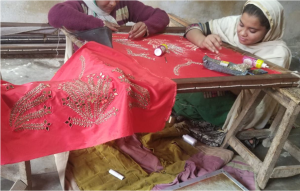On 24 April 2013, an eight-story building housing five garment factories collapsed in Dhaka, Bangladesh. Over 1000 people were killed and 2500 injured. The collapse shed an uncomfortable light on inhumane conditions faced by workers in the textile industry. Factors such as overcrowding, disregard for safety and working overtime to meet tight deadlines all contributed to the deadliest garment-factory disaster in history.
The Rana Plaza collapse is regarded by some as a turning point in supply chain regulation and transparency. News crews filming the destruction caught glimpses of logos from well-known fashion brands among the rubble. Consumers began to wonder about where their clothes came from, and the lives of the people who made them.
Putting professional experience to use
Enter Ranit Sinha. Ranit, originally from India, worked in the garment industry in Asia for ten years before deciding to continue his education in Luxembourg. After completing his Master’s degree in Logistics and Supply Chain Management, Ranit decided to begin a PhD at the Doctoral School of Economics, Finance and Management. His unique background and first-hand experience with the industry, combined with the econometric methods that he learned during his studies, inspired him to develop an innovative way for companies to ensure that their supply chains are free of modern slavery and worker exploitation.
Non-compliance with regulations and standards is usually detected through in-person audits, explains Ranit. However, these inspections are problematic in many ways. Firstly, it is expensive for companies to audit all of their suppliers and secondly, audits are always ‘pre-emptive,’ meaning that suppliers are given advance notice, allowing them to present a false image of their operations. Speaking with workers is not helpful either, as many may be under coercion and fear losing their employment.
An econometric model to identify high risk suppliers
With this in mind, Ranit set about to develop a method to identify and measure the ‘risk of prevalence of modern slavery’ in the garment industry. Together with Ranit’s industry knowledge and thesis supervisor Prof. Joachim Arts’ academic expertise, the pair are building a robust audit mechanism to identify high-risk suppliers using state-of-the-art econometric models. Instead of relying on easily falsified and expensive in-person audits, the technique uses publicly or commercially available data, and established models such as the Cobb-Douglas production function
Using this function, it is possible to predict how many products can be realistically produced at a factory which employs a certain number of people, uses a certain number of machines and is compliant with all labour laws and regulations. Then, this estimate can be compared with how many products the company exported, based on shipment data such as the bill of lading. If the difference is significant, then the supplier can be flagged for closer follow-up. If a supplier is producing more than what is expected by the model, they may be employing workers illegally or forcing workers to work longer hours than what is allowed by law.
With companies under pressure from concerned consumers and increasing government regulations designed to address modern slavery, the race is on to prove compliance and obtain the necessary certifications. Fashion brands with thousands of suppliers can utilize the results of Ranit’s approach to concentrate their efforts on investigating conditions at ‘high risk’ suppliers, thereby reducing their audit cost and improving their compliance efficacy. NGOs and other associations may also benefit from access to this data, Ranit says. They can use it to support efforts to improve worker conditions in identified factories more efficiently and develop targeted campaigns to raise awareness.
Current challenges and future opportunities
Ranit is realistic, however, in terms of the extent to which such tools can help combat problems of modern slavery. As he speaks of his groundwork in a low-cost garment-exporting country, he mentions visits to subcontractors where debt-bonded workers live on-site in harsh conditions. Workers at such establishments (informal tier 3 factories) are often from vulnerable and marginalised migrant populations. These firms, to which larger companies usually outsource manual tasks such as embroidery, embellishment, or thread cutting, are often unregistered and untraceable, and therefore do not appear in the official supply chain and frequently remain outside the scope of compliance audits.
Looking towards the future, Ranit hopes that his method will have commercial appeal. He points to AI-based models currently in development by various start-ups. These models process generic statistics such as electricity and water usage at factories and to find discrepancies between reported and actual data. In contrast, Ranit has set his sights on developing an AI-model with an industry approach. His model could be tailored to each activity, whether it be garment manufacturing, cocoa production or palm oil farming. He hopes to offer companies an easier and cheaper way to keep an eye on their supply chains, and a path towards reducing worker exploitation around the globe.
Photo credit: Ranit Sinha
